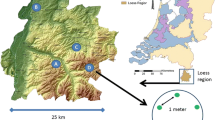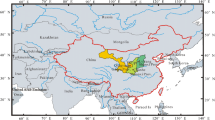Abstract
Physical separation methods are normally preferred over chemical methods, but their efficiency often fails to meet the remediation targets for various reasons. Attrition scrubbing could possibly be used to improve their effectiveness. The aim of this study was to demonstrate the usefulness of attrition scrubbing prior to a gravity separation technique and to understand the mode of action involved. Contaminated soil divided into three fractions (0.250–1-, 1–2-, and 2–4-mm) and containing six inorganic contaminants was submitted to attrition scrubbing prior to a gravity separation method (shaking table or jig). The proportions and contaminant contents of attrition sludges and separation products were characterized. A dense media separation was realized to predict the efficiency of gravity separation. The shape of particles and the liberation of contaminants for the 0.250- to 1-mm soil fraction were characterized from image analysis. Attrition significantly improved the gravity separation efficiency for five out of six contaminants. However, attrition moderately impacted the gravity separation efficiency of contaminants for coarser soil fractions. Attrition significantly improved the sphericity of particles from the 0.250- to 1-mm fraction of 3 % and significantly reduced their size. The liberation of contaminants was also increased for Pb and Sn together from 17 % for the same soil fraction. However, despite the attrition scrubbing treatment, differences in the removal efficiencies between the dense media separation and the gravity separation remain important for most of the contaminants. This study suggests that the attrition scrubbing effects and mode of action depend on the size of particles.




Similar content being viewed by others
References
Bartlett, J. E., Kotrlik, J. W., & Higgins, C. C. (2001). Organizational research: determining appropriate sample size in survey research. Information Technology, Learning, and Performance Journal, 19(1), 43–50.
Bayley, R. W., & Biggs, C. A. (2005). Characterisation of an attrition scrubber for the removal of high molecular weight contaminants in sand. Chemical Engineering Journal, 111(1), 71–79.
Bisone, S. (2012). Décontamination de sols contaminés par du cuivre du zinc et des HAP provenant de déchets métallurgiques. Université du Québec, Institut national de la recherche scientifique, Québec, QC, Canada, p. 254.
Bisone, S., Mercier, G., & Blais, J.-F. (2013). Decontamination of metals and polycyclic aromatic hydrocarbons from slag-polluted soil. Environmental Technology, 34(18), 2633–2648.
Blais, J.-F., Meunier, N., & Mercier, G. (2010). New technologies for toxic metals removal from contaminated sites. Recent Patents on Engineering, 4(1), 1–6.
Brown, T. (2007). Engineering economics and economic design for process engineers. Boca Raton: CRC Press, Taylor & Francis Group.
Bunge, R., & Vogler, K. (1995). Assessing the suitability of contaminated soils for soil washing. In W. J. Brink, R. Bosman, & F. Arendt (Eds.), Contaminated soil ’95 (Vol. 5, pp. 491–493). Netherlands: Springer. Soil & Environment.
CEAEQ (2003). Détermination des métaux et du phosphore dans les sédiments: méthode par spectrométrie au plasma d'argon après minéralisation acide. (pp. 18): Ministère de l'Environnement du Québec.
CEAEQ (2014). Détermination du pH : méthode électrométrique (pp. 14): Ministère du Développement durable, de l’Environnement et de la Lutte contre les changements climatiques du Québec.
Cochran, W. G. (1977). Sampling techniques (3rd ed.). New York: Wiley.
Duchesne, J., & Mercier, G. (2003). Establishment of a method for mineralogical characterization describing lead-contaminated soils. Canadian Geotechnical Journal, 40(4), 731–741.
FRTR (2013). Remediation technologies screening matrix and reference guide version 4.0 http://www.frtr.gov/matrix2/top_page.html.
Gosselin, A., Blackburn, D., & Bergeron, M. (1999). Protocole d'évaluation de la traitabilité des sédiments, des sols et des boues à l'aide des technologies minéralurgiques. (pp. 148): Environnement Canada.
Grobler, J. D., & Bosman, J. B. (2011). Gravity separator performance evaluation using Qemscan (R) particle mineral analysis. Journal of the South African Institute of Mining and Metallurgy, 111(6), 401–408.
Iskandar, I. K. (2001). Environmental restoration of metals-contaminated soils. Boca Raton: Lewis Publishers CRC Press.
IUSS (2014). World Reference Base for Soil Resources 2014: International soil classification system for naming soils and creating legends for soil maps. World Soil Resources Reports no 106 (pp. 181). Rome: FAO.
Jiang, X. M., Zhou, L. S., Liu, J. G., & Han, X. X. (2009). A model on attrition of quartzite particles as a bed material in fluidized beds. Powder Technology, 195(1), 44–49.
Laporte-Saumure, M., Martel, R., & Mercier, G. (2010). Evaluation of physicochemical methods for treatment of Cu, Pb, Sb, and Zn in Canadian small arm firing ranges backstop soils. Water, Air, & Soil Pollution, 213(1-4), 171–189.
Manser, R. J., Barley, R. W., & Wills, B. A. (1991). The shaking table concentrator—the influence of operating-conditions and table parameters on mineral separation—the development of a mathematical-model for normal operating-conditions. Minerals Engineering, 4(3-4), 369–381.
Marino, M. A., Brica, R. M., & Neale, C. N. (1997). Heavy metal soil remediation: the effects of attrition scrubbing on a wet gravity concentration process. Environmental Progress, 16(3), 208–214.
McClenaghan, M. B. (2011). Overview of common processing methods for recovery of indicator minerals from sediment and bedrock in mineral exploration. Geochemistry-Exploration Environment Analysis, 11(4), 265–278.
Mercier, G., Duchesne, J., & Blackburn, D. (2001). Prediction of metal removal efficiency from contaminated soils by physical methods. Journal of Environmental Engineering-Asce, 127(4), 348–358.
Ravier, J. (1988). Tentative de quantification de la forme des particules. Bulletin de liaison Laboratoire des ponts et chaussées, 157, 39–46.
Rendek, E., Ducom, G., & Germain, P. (2006). Influence of organic matter on municipal solid waste incinerator bottom ash carbonation. Chemosphere, 64(7), 1212–1218.
Rikers, R. A., Rem, P., & Dalmijn, W. L. (1998). Improved method for prediction of heavy metal recoveries from soil using high intensity magnetic separation (HIMS). International Journal of Mineral Processing, 54(3–4), 165–182.
Strazisar, J., & Seselj, A. (1999). Attrition as a process of comminution and separation. Powder Technology, 105(1–3), 205–209.
Ulrich, G. (1984). A guide to chemical engineering process design and economics. New York: Wiley.
USDA (1993). Soil survey manual: soil survey division staff-soil conservation service. US Department of Agriculture Handbook 18, USA, p. 315.
Williford, C. W., Li, Z., Wang, Z. M., & Bricka, R. M. (1999). Vertical column hydroclassification of metal-contaminated soils. Journal of Hazardous Materials, 66(1-2), 15–30.
Wills, B. A. (1992). Mineral processing technology. N.Y.: Pergamon.
Zhao, Y., Zhang, Y., Bao, S., Liu, T., Bian, Y., Liu, X., et al. (2013). Separation factor of shaking table for vanadium pre-concentration from stone coal. Separation and Purification Technology, 115, 92–99.
Acknowledgments
The project was funded by the National Sciences and Engineering Research Council of Canada and Tecosolinc. The authors thank Myriam Chartier and Lucie Coudert for their assistance.
Author information
Authors and Affiliations
Corresponding author
Rights and permissions
About this article
Cite this article
Jobin, P., Mercier, G., Blais, JF. et al. Understanding the Effect of Attrition Scrubbing on the Efficiency of Gravity Separation of Six Inorganic Contaminants. Water Air Soil Pollut 226, 162 (2015). https://doi.org/10.1007/s11270-015-2422-6
Received:
Accepted:
Published:
DOI: https://doi.org/10.1007/s11270-015-2422-6




